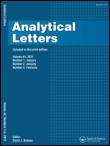
ANALYTICAL LETTERS
Scope & Guideline
Bridging Theory and Application in Chemistry
Introduction
Aims and Scopes
- Methodological Innovations in Analytical Techniques:
The journal emphasizes advancements in analytical methodologies, including new extraction techniques, sensor development, and novel instrumentation tailored for sensitive and specific detection of various analytes. - Environmental and Food Safety Analysis:
A significant focus is placed on the analysis of environmental samples and food safety, highlighting the importance of detecting contaminants, pesticides, and toxic elements to ensure public health and environmental protection. - Biochemical and Clinical Applications:
Research exploring the biochemical analysis of biological samples, particularly for clinical diagnostics and therapeutic monitoring, is a core area, showcasing the journal's dedication to interdisciplinary applications of analytical chemistry. - Nanomaterials and Green Chemistry:
The journal frequently publishes studies on the use of nanomaterials and green chemistry approaches, reflecting a commitment to sustainable practices in analytical methods and materials. - Chemometric Applications:
The application of chemometrics for data analysis and interpretation in analytical chemistry is a recurring theme, illustrating the integration of statistical methods with experimental data to enhance analytical results.
Trending and Emerging
- Electrochemical Sensing Technologies:
There is a notable increase in research focused on electrochemical sensors, particularly those utilizing nanomaterials for enhanced sensitivity and selectivity in detecting various biomolecules and environmental pollutants. - Integration of Machine Learning and Artificial Intelligence:
The application of machine learning and AI in data analysis and method development is gaining traction, reflecting a trend towards automating and improving the accuracy of analytical processes. - Sustainable Analytical Practices:
Research emphasizing green chemistry principles and sustainable practices in analytical methods is on the rise, showcasing a growing awareness and commitment to environmental considerations within the field. - Multidimensional Analytical Approaches:
There is a trend towards multi-faceted analytical strategies that combine various techniques (e.g., chromatography with mass spectrometry), enhancing the comprehensiveness and reliability of analytical results. - Focus on Health and Environmental Impact Assessments:
The journal is increasingly publishing studies that assess the health impacts of pollutants and contaminants, as well as the environmental implications of analytical findings, aligning with global health and sustainability agendas.
Declining or Waning
- Traditional Spectroscopy Techniques:
There appears to be a waning interest in conventional spectroscopic techniques such as UV-Vis spectroscopy, which have been largely overshadowed by more advanced methods like mass spectrometry and chromatography that offer higher sensitivity and specificity. - Basic Analytical Methods for Common Analytes:
Research focused on the basic determination of common analytes has decreased, as the field evolves towards more complex and integrated analyses, incorporating advanced technologies and methodologies. - Long-established Extraction Techniques:
Traditional extraction methods are being replaced by novel approaches such as deep eutectic solvent-based extractions and other innovative techniques, leading to a reduction in publications related to older extraction methodologies.
Similar Journals

Mass Spectrometry Letters
Unveiling the Future of Mass Spectrometry Research.Mass Spectrometry Letters is a pioneering open-access journal published by the Korean Society for Mass Spectrometry, specializing in the diverse fields of analytical chemistry, biochemistry, and spectroscopy. Established in 2010, this journal aims to disseminate groundbreaking research and advancements in mass spectrometry and its applications across various scientific domains. Though currently categorized in the Q4 quartile in key analytical fields, Mass Spectrometry Letters serves as an essential platform for researchers, professionals, and students to share innovative methodologies, emerging trends, and practical applications of mass spectrometry, thus fostering collaboration and advancing knowledge in the scientific community. With a commitment to open access, articles published since 2010 are readily available, enabling widespread distribution and engagement within the international research community. Located in Daejeon, South Korea, and actively converging research through 2024, the journal holds the potential to grow its impact and relevance within the dynamic landscape of mass spectrometry.

CHEMICAL PAPERS
Catalyzing Knowledge in Chemical EngineeringChemical Papers is a distinguished scientific journal published by Springer International Publishing AG, catering to the fields of Biochemistry, Chemical Engineering, and Materials Chemistry. With an ISSN of 0366-6352 and an E-ISSN of 2585-7290, this journal has been a pivotal platform for the dissemination of research findings since its inception in 1973. Over the years, it has maintained a strong academic presence, as evidenced by its Q2 and Q3 rankings in several pertinent categories as of 2023, including Chemical Engineering and Industrial and Manufacturing Engineering. Although the journal is not currently Open Access, it remains an invaluable resource for researchers and professionals across its scope, promoting the advancement of knowledge in chemical sciences and fostering innovation within the industry. The publication is headquartered in Cham, Switzerland, contributing to a global dialogue on chemical research and its applications.

ACS Food Science & Technology
Unveiling the Science Behind Every BiteACS Food Science & Technology is a premier peer-reviewed journal published by the American Chemical Society (ACS) that addresses the dynamic intersections of food science, chemistry, and technology. With its E-ISSN: 2692-1944, this journal aims to disseminate innovative research and comprehensive reviews that enhance understanding in fields such as analytical chemistry, organic chemistry, and general food science. Despite the absence of an Open Access model, its position in the Q2 quartile for multiple categories in 2023 underscores its significant impact on the scholarly landscape, ensuring researchers can access high-quality research pertinent to today's food challenges. With an expanding timeline of 2021 to 2024, ACS Food Science & Technology is poised to be an essential resource for advancing the scientific community's knowledge, fostering collaboration, and bridging gaps between academia and industry.
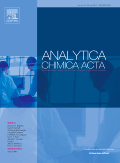
Analytica Chimica Acta
Exploring the depths of analytical methodologies since 1947.Analytica Chimica Acta is a prestigious peer-reviewed journal published by ELSEVIER, renowned for its significant contribution to the fields of analytical chemistry, biochemistry, environmental chemistry, and spectroscopy. Established in 1947, this journal has solidified its reputation, reflected in its impressive impact factors and Scopus rankings, including a Q1 classification in Analytical Chemistry and Spectroscopy, and a Q2 ranking in both Biochemistry and Environmental Chemistry. With its comprehensive scope, Analytica Chimica Acta aims to publish innovative research, critical reviews, and technical notes that advance the understanding and application of analytical methods. As an essential resource for researchers, professionals, and students alike, it encourages the dissemination of high-quality research that addresses contemporary challenges in chemical analysis and promotes interdisciplinary collaboration. While the journal operates primarily on a subscription basis, it also offers unique opportunities for authors to reach a broad audience and engage in the global scientific discourse.

JOURNAL OF ANALYTICAL CHEMISTRY
Driving Innovation in Analytical ResearchJOURNAL OF ANALYTICAL CHEMISTRY, published by PLEIADES PUBLISHING INC, stands as a pivotal resource in the field of analytical chemistry, offering an innovative platform for researchers, professionals, and students to advance their knowledge and contribute to the discourse within the discipline. With an ISSN of 1061-9348 and an E-ISSN of 1608-3199, this journal features a focused exploration of analytical methodologies, instrumentation developments, and applications across various domains, contributing to practical and theoretical advancements in the field. Currently ranked in the Q3 category in Analytical Chemistry with a Scopus rank of #111 out of 156, it provides critical insights and innovation strategies for professionals aiming to enhance their analytical capabilities. Access to the journal is through standard subscription models, and it covers an extensive range of topics pertinent to the discipline from 1996 to 2024. Engage with the JOURNAL OF ANALYTICAL CHEMISTRY to be part of a vibrant research community dedicated to push the boundaries of analytical practices.

CHINESE JOURNAL OF ANALYTICAL CHEMISTRY
Fostering Scientific Inquiry in Analytical ChemistryCHINESE JOURNAL OF ANALYTICAL CHEMISTRY, published by SCIENCE PRESS in China, stands as a prominent platform in the field of analytical chemistry since its inception in 1989. With its ISSN 0253-3820 and E-ISSN 1872-2040, the journal maintains a vital role in disseminating empirical research and innovative methodologies, contributing to the advancement of analytical techniques and their applications. The 2023 Scopus ranking positions the journal in the third quartile (Q3) within its category, reflecting a respectable standing among its peers. Researchers, professionals, and students alike engage with a broad range of topics, from instrumental analysis to environmental monitoring, each aiming to foster further scientific inquiry. Although it does not currently offer Open Access, the journal's rich repository of knowledge continues to be an essential resource for those in the analytical chemistry community, with an enduring commitment to scientific excellence and collaboration.
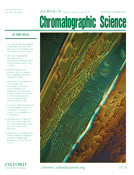
JOURNAL OF CHROMATOGRAPHIC SCIENCE
Fostering Knowledge for Analytical BreakthroughsWelcome to the Journal of Chromatographic Science, a premier publication dedicated to advancing the scientific understanding of chromatographic techniques and their applications across various disciplines. Published by Oxford University Press Inc, this journal, with its ISSN 0021-9665 and E-ISSN 1945-239X, has been disseminating innovative research since 1963, serving as a vital resource for researchers, industry professionals, and academic scholars in the fields of Analytical Chemistry and Medicine. As evidenced by its 2023 Scopus ranking, the journal stands at the Q3 quartile in both its primary disciplines, highlighting its relevance and contribution to ongoing research. The journal promotes high-quality, peer-reviewed articles that aim to foster knowledge and encourage the practical application of chromatographic science. While it operates under a traditional subscription model, the valuable insights it offers are essential for those seeking to enhance their expertise and stay at the forefront of chromatographic methodologies. Join our community of scholars as we explore the complexities and innovations in chromatographic science, paving the way for future discoveries.
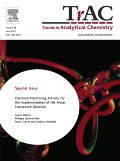
TRAC-TRENDS IN ANALYTICAL CHEMISTRY
Advancing Knowledge in Analytical ChemistryTRAC - Trends in Analytical Chemistry is a prestigious journal published by Elsevier Science Ltd, situated in the Netherlands. With an impressive impact factor reflected in its Q1 rankings across three major categories—Analytical Chemistry, Environmental Chemistry, and Spectroscopy—this journal stands at the forefront of disseminating pioneering research and advancements in the field of analytical chemistry. Established in 1981, TRAC provides a comprehensive platform for researchers to share influential studies and insights related to the latest trends, methodologies, and technologies in analytical techniques. Recognized globally, the journal excels in fostering cross-disciplinary dialogue and innovation, making it an indispensable resource for academics, professionals, and students alike. Explore the latest issues to stay abreast of cutting-edge developments that shape the analytical sciences.

Pakistan Journal of Analytical & Environmental Chemistry
Unveiling Insights into Analytical MethodologiesPakistan Journal of Analytical & Environmental Chemistry, published by the University of Sindh, National Centre of Excellence Analytical Chemistry, is a distinguished platform that has been committed to promoting high-quality research in the fields of analytical and environmental chemistry since its inception. With an ISSN of 1996-918X and an E-ISSN of 2221-5255, this journal has established itself as an open-access resource since 2007, facilitating the dissemination of knowledge to a global audience. Acknowledged for its contributions, the journal currently holds a Q4 category ranking in both Analytical Chemistry and Environmental Chemistry as of 2023, with Scopus rankings placing it within the challenging competitive bracket. The journal aims to publish original research, reviews, and technical notes that elucidate contemporary challenges and advancements, making it an essential read for researchers, professionals, and students who are exploring innovative methodologies and solutions in chemical analysis and environmental monitoring. By fostering a collaborative research environment and encouraging multidisciplinary approaches, the Pakistan Journal of Analytical & Environmental Chemistry plays a crucial role in advancing the field and addressing environmental concerns in Pakistan and beyond.
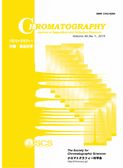
Chromatography
Exploring the frontiers of chromatography and its applications.Chromatography is an esteemed journal published by the SOC CHROMATOGRAPHIC SCIENCES, dedicated to advancing the field of chromatographic techniques and their applications across various disciplines, including analytical chemistry, biochemistry, and environmental science. By facilitating the exchange of high-quality research, Chromatography plays a pivotal role in enhancing methodologies and technologies that drive innovation in sample analysis. While the journal is not currently open access, it maintains a rigorous peer-review process, ensuring the publication of valuable and impactful studies. Researchers, professionals, and students alike can benefit from its comprehensive coverage of chromatography-related advancements, making it a vital resource for anyone engaged in this dynamic area of study.